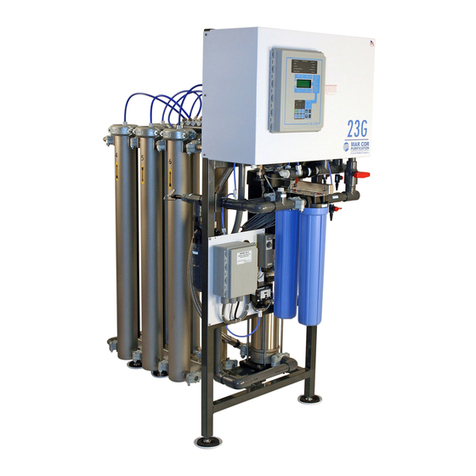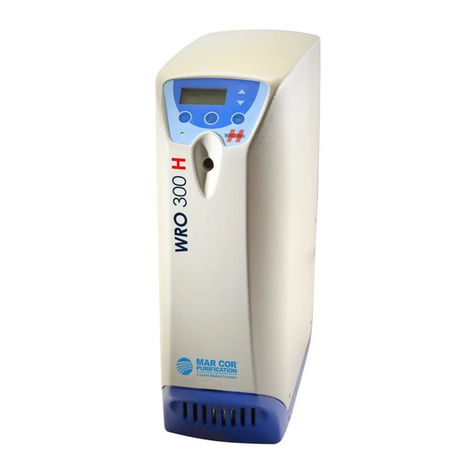
M-Series Water Purification Machines
1238160 Rev. D 1 - 5 Description
Given the system case in Figure 2:
Average Concentration (Cavg) = (Cf) 100 mg/L + (Cc) 146.9 mg/L
2
(Cavg) = 123.5 mg/L TDS
Rejection = (Cavg) 123.5 – (Cp) 6.2 x 100 = 95%
(C
avg) 123.5
Passage = (Cp) = 6.2 x 100% = 5.0%
(Cavg) 123.5
Recovery = (Qp) 2 gpm x 100 = 33%
(Qf) 6 gpm
FLOW DESCRIPTION:
The feedwater passes through a replaceable 5-micron cartridge filter,
which removes bulk suspended solids. Filtered water then flows to the inlet
control valve. This solenoid-controlled diaphragm valve is wired to the
on/off switch and opens when the machine is turned on allowing water to
flow to the pump inlet. When the machine is turned off, the valve closes,
preventing non-turbulent flow through the sepralators, that would lead to
shortened membrane life.
The pump feeds water to the sepralator housings arranged in parallel and
serial combinations. An arrow on each element housing indicates the
direction of water flow. The water is sepralated by the membrane within
the elements and leaves the housings in two streams as permeate and
concentrate.
Permeate from each sepralator housing is collected in a common manifold.
A pressure relief valve is installed to alleviate excessive backpressure
build-up. The permeate then flows through a flow meter and to the outlet
point of the machine.
The concentrate leaves the last sepralator housing and flows to the flow
control center. At this point, the recycle valve channels a predetermined
amount of concentrate into the pump inlet. This achieves more efficient
water recovery while maintaining adequate crossflow through the
sepralators. The other two ports of the flow control center lead to the
concentrate valve and final pressure gauge. The concentrate valve has
three functions: It controls the amount of concentrate flowing to the drain; it
controls the pressure within the machine, and it helps control the system
recovery. An optional autoflush solenoid is added to the flow control center
with an additional tee. The concentrate then flows through a flow meter
and to the outlet point of the machine.































